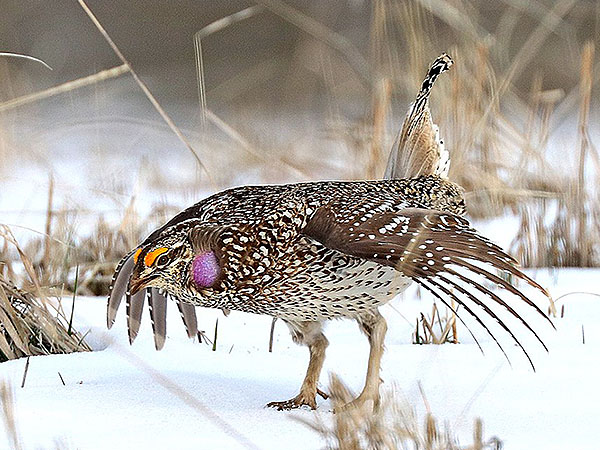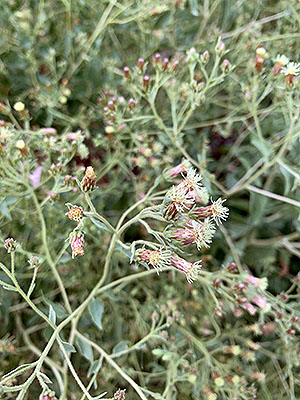Lost Sunflower (Helianthus praetermissus)
The Lost Sunflower is an enigmatic species only known from a single specimen that was collected in 1851 in Cibola County in western New Mexico, USA.
The species was superficially quite similar to the Common Sunflower (Helianthus annuus L.), from which it differed by its rather narrow linear leaves; it was annual, reached a size of about 90 cm and had a single large flower with yellow florets.
***
The Lost Sunflower may be an extinct species, however, there is the possibility that it might turn out to be identical with the Pecos Sunflower (Helianthus paradoxus Heiser), itself an endangered species.
*********************
edited: 06.09.2020
Tag Archives: New Mexico
Isoperla jewetti Szczytko & Stewart
Grande Stripetail Stonefly (Isoperla jewetti)
This species was described in 1976 from specimens that had been collected in 1939 from a single location in El Paso County, Texas, which is now completely destroyed by agriculture.
The species is furthermore known from a single specimen collected in Huerfano County, Colorado, and from at least six nymph specimens that were collected in Dona Ana County, New Mexico.
The Grande Stripetail Stonefly was not recorded since 1980 and is most likely extinct.
*********************
edited: 31.10.2017
Amphinaias couchiana (Lea)
Rio Grande Monkeyface (Amphinaias couchiana)
The Rio Grande Monkeyface is known, on the one hand, from subfossil remains from the Pecos River drainage in New Mexico, USA, but on the other hand also from live specimens from the Rio Grande in Texas, USA as well as from the Río Conchos in Chihuahua and from the Río Salado in Tamaulipas (both in Mexico).
The last living specimes of this species have been collected in the year 1898 near Bracketville in the Kinney County in Texas.
***
The Rio Grande Monkeyface is very possibly extinct, there exists, however, a vaguely possibility, that a population may still survive at least somewhere in Mexico.
*********************
edited: 13.12.2012
Tympanuchus phasianellus ssp. hueyi Dickerman & Hubbard
New Mexican Sharp-tailed Grouse (Tympanuchus phasianellus ssp. hueyi)
The New Mexico Sharp-tailed Grouse is known from nine specimens; it was described as being distinct from other populations in 1994, at a time when it was already extinct.
This subspecies inhabited the prairies in parts of New Mexico and maybe also in adjacent parts of Colorado, USA; it disappeared due to the effects of human settlement including clearing of land for farming and overgrazing by livestock in the late 19th- and early 20th century.
The last birds were recorded in 1952 on the Sewell Ranch in Colfax County, New Mexico.
*********************
References:
[1] Robert W. Dickerman; John P. Hubbard: An extinct subspecies of Sharp-tailed Grouse from New Mexico. Western Birds 25: 128-136. 1994
*********************

Photo: Alan Schmierer
(not in copyright)
*********************
edited: 29.04.2021
Pyrgulopsis chupaderae (Taylor)
Chupadera Pyrg (Pyrgulopsis chupaderae)
The Chupadera Pyrg was described in 1987, it was restricted to its type locality, Willow Spring on the Cienaga Ranch at the southern end of the Chupadera Mountains in Socorro County, New Mexico, USA. [1]
***
There appears to be a last surviving population of this species located on private land, however, given the fact that groundwater pumping is not really regulated, this last population may already be extinct as well, this cannot be proven because the landowners are uncooperative. [2]
*********************
References:
[1] Robert Hershler: A review of the North American freshwater snail genus Pyrgulopsis (Hydrobiidae). Smithsonian Libraries 554(554): 1-115. 1994
[2] Robert hershler; Hsiu-Ping Liu; Jeanette Howard: Springsnails: A new conservation focus in western North America. BioScience 64(8): 693-700. 2014
*********************
edited: 01.05.2019
Limnebius aridus Perkins
Animas Limnebius Minute Moss Beetle (Limnebius aridus)
The species of this genus usually live in the bank substrate along mountain streams; they require certain particle- and gap sizes and are therefore very sensitive to soil silting.
***
The Animas Limnebius Minute Moss Beetle was described in 1980, it is only known from a single collection that was made in 1952 on the Double Adobe Ranch in the Animas Mountains in Hildago County in New Mexico, USA.
The biology is or was probably identical to that of other species of the genus.
*********************
edited: 02.05.2021
Brickellia chenopodina (Greene ex Wooton & Standl.) B. L. Rob.
The Gila Brickellbush is known only from the type that was collected in 1903 from alluvial soil at the river bank of the Gila River in Grant County, New Mexico, USA.
The species was never found since and is considered extinct.
***
The species is not accepted by all botanists and is considered by some to be an aberrant individual of the Chihuahuan Brickellbush (Brickellia floribunda A. Gray) (see photo below).
*********************

Chihuahuan Brickellbush (Brickellia floribunda)
Photo: Conor Flynn
https://ecuador.inaturalist.org/people/conorflynn
(under creative commons license (4.0))
https://creativecommons.org/licenses/by-nc/4.0/
*********************
edited: 25.04.2022
Tremarctos floridanus (Gildey)
Florida Spectacled Bear (Tremarctos floridanus)
The short-faced bears, so named for the shape of their skulls, which appear to have a disproportionately short snout compared to other bears, are a subfamily (Tremarctinae) of the bears that are/were restricted to the Americas. Only a single species survives until today, the Spectacled Bear (Tremarctos ornatus (Cuvier)) of South America.
***
The Florida Spectacled Bear, described in 1928 based on fossil bones from Pleistocene deposits, inhabited the southern parts of North America, including Mexico, as well as Florida, Georgia, New Mexico, and Tennessee, USA.
The species differed from its South American counterpart by its much larger size and its heavier proportions.
The Florida Spectacled Bear was mainly a Pleistocene species and disappeared at the end of that epoch, however, bones of the species, found at Delvil’s Den, a flooded karst cave in Florida, were dated to an age of about 8000 BC, indicating that the species may have survived for a somewhat longer time. [1]
*********************
References:
[1] B. Kurtén; E. Anderson: Pleistocene Mammals of North America. Columbia University Press 1980
*********************
edited: 04.11.2017
